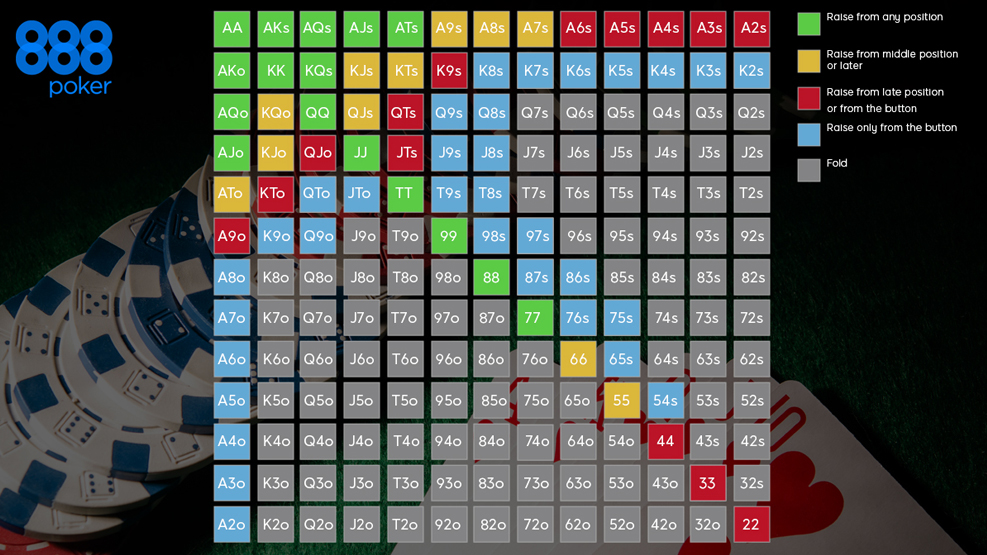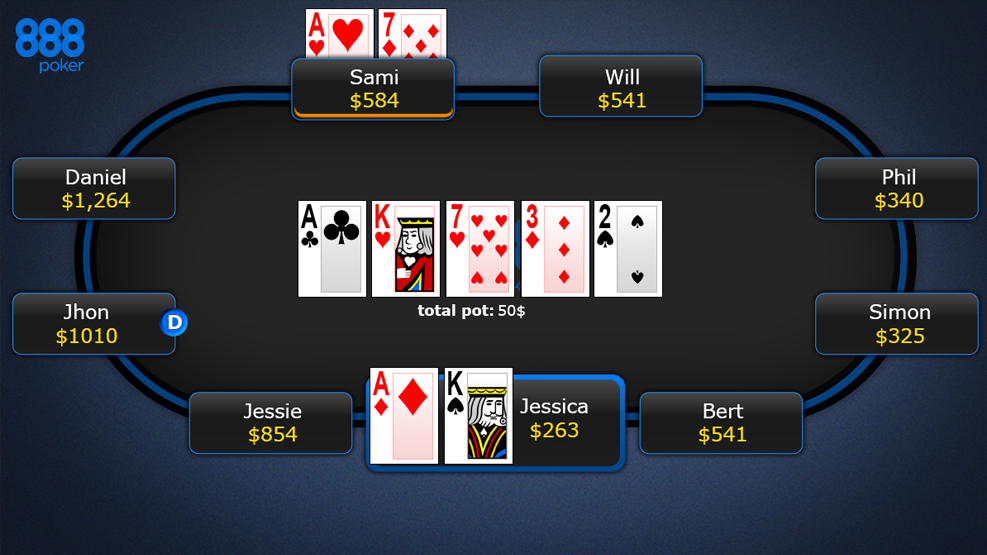Texas Hold’em Poker Strategy: 5 Rules to Live by

Poker strategy is everything. Anyone who says otherwise is kidding themselves. Yet, it’s unbelievable how many poker players ante up for a war of attrition against seasoned poker veterans without any strategy in mind. It’s like getting into a jousting contest without metal body armor in place – that would simply never happen. But it does happen, and it occurs with increasing alacrity. Too many poker players are way too eager to hop into the ring without any training, skills, or knowledge of poker rules, nuances, and betting behavior. As the old saying goes: If you don’t know where you’re going, any road will take you there. Unfortunately, the ‘strategy-less’ poker player invariably ends up being relegated to the rail.
Now, you can put your fears to rest. 888poker USA has compiled a detailed poker strategy guide to help you understand everything that you need to know before you enter the murky depths where poker sharks, whales, and fish lie in wait.
Suit up – we’re about to begin!
Isn’t it amazing that so few people understand the differences between tactics and strategies. Let’s break it down: tactics are short-term oriented, while strategies are long-term oriented. That’s the most important difference between the two. The individual plays that you make during a round of poker are your tactics. The strategy is your overall game plan.
There are basically 5 strategic areas that you should focus your attention on while you’re playing Texas Hold'em cash games. Tournament strategy for Texas Hold’em differs considerably from cash game strategy, and there are a host of other tips that determine how to play in tourneys.
If you ask 5 different people, chances are you’ll get many different answers about the best poker strategies to adopt. Fortunately, there are many overlaps, and this is where we’re going to focus our attention. The top 5 strategies for novice poker players, and intermediate-level poker players include the following: Opening Hands, Bet Sizing, Limping, Folding, and Positioning.
Once you’ve mastered these 5 Texas Hold’em poker strategies, you’ll be able to incorporate many other strategies into your overall game plan. Luckily, these strategies will set you on the path to Texas Hold’em glory. Let’s get started!
#1 – Opening Hands
Remember, poker is a battle royale. When you prepare to don your battle armor, be sure that you’ve got a premium opening hand to protect you. Starting hands are 1 component of your overall poker game. Position is equally important when it comes to determining which hands you should hold, and which hands you should fold. The types of starting hands that you can play are typically much wider the closer you get to the button.

Don’t forget that the number of players in a hand is equally important. Your payoff for a hand may be less when you play against 6 players than when you’re playing against 1 player. Conversely, the same hand may be great for bluffing when you go into the heads-up contest because there’s only one other player that you need to convince that you’re holding the nuts.
Hand strength is but one factor to consider when deciding which opening hands to play. It’s equally important how that hand can generate income under any conditions. In a heads up poker pot, a small suited connector is much better to bluff with, but it has greater multi-way value. It is atypical that a suited connector will do well in heads-up, and even less likely that you’d be able to bluff with such a hand in a multi-way poker pot.
With that in mind, choose your opening hand carefully. It’s important to have an idea about how you are going to generate income post-flop. If you don’t have a clue how the hand you’re holding is going to make money Post-Flop, on the Turn and River, it’s probably not a good hand to play. Rather forget it.
#2 – Betting with Confidence
When you’re playing NL cash games you can literally pick whatever you have available. Unfortunately, all that freedom comes with a caveat: you can go bust or get into debt very quickly. That’s why bet sizing – careful bet selection – is so important. This is one of the most important strategic rules of Texas Hold’em poker.
Bet Sizing in the Pre-Flop Stage of Texas Hold’em
If you need advice on how to size your bets correctly, look around you. What’s going on at your table? If the pre-Flop raise is 2.5 times the Big Blind, then you as a novice poker player should adopt this line. If you try to outsmart other players and raise a weird amount, it could work against you. Your bet sizing must be sensible to your opponents, since they understand the game and how it’s supposed to be played.
If you raise in unusual increments, you simply make it more difficult for other players to make decisions against you. If they find it difficult to size their bets during the post-flop stage, this may work in your favor. In the pre-flop stage, it’ll end up biting you in the behind.
Bet Sizing in the Post-Flop Stage of Texas Hold’em
Let’s take a look at what happens post-flop. If you raise in the pre-flop stage, a continuation bet is expected. You should always correctly size your continuation bets around 50% - 70% of the pot size. Your bet size also defines how strong your hand is. This is true when you’re playing poker at lower levels of the game. Many novice poker players consider a C-Bet (continuation bet) as a sign of strength. You will typically do well with these continuation bets regardless of what happens on the Flop.
Here’s the thing; you want the other players at the table to assume that you have them cornered. If your betting is too small, you will invariably end up facing a check raise, or a re-raise, depending on where you’re sitting at the table. If you bet too big, you may be stuck in a hand that’s not worth playing.
Clearly, there must be more to bet sizing than intuition. Here is an example about how to size your bets correctly:
Let’s say you’re under the gun +1 in a 9-Max game of poker with stakes of $1/$2 in an NLH cash game. If you’re dealt pocket Jacks and then you decide to raise the table standard of 2.5 times the Big Blind, let’s see what can happen. If this hand gets folded and then the Button decides to call, and then both blinds fold, the Flop may come down with the following combination: Ace of diamonds-6 of hearts-2 of spades. Clearly, the Ace has some clout, but you may feel that the Button player would likely 3-bet with an Ace. Had the button held a weak Ace, that player would have folded. If your bet is too small, a savvy poker player would definitely raise you, representing the Ace, and you’d get bluffed out of the pot. Now, let’s assume that you bet two thirds of the pot. What could happen? You could get your opponent to fold!
Clearly, poker strategy doesn’t always pan out. Sometimes your opponent will call you with that suited Ace. And if the board shows 7 of diamonds-8 of diamonds-9 of diamonds, and you are holding an Ace of spades-King of spades, a continuation bet (C-Bet) could be a waste of time and money. Fortunately, the right size continuation bet usually gets your opponents to fold and results in your winning the poker pot.
Bet Sizing Where Bluffs Are Involved
Few poker players can resist an attempt at bluffing. Let’s assume a pot size of $20 and you assume that there is a great chance that your opponent is going to fold. If you place a $20 bet, you could be in a spot of bother if you are wrong. This would be a weak bet size if the person opposite you decides to fold to a $10 bet. If you fail on the bluff, you’ll lose another $10 – what a waste.
Bet Sizing When You Have the Nuts
Are you ready to turn things around? Let’s say you’re holding the nuts – you got a great hand. Now you should always bet for value. Once you hit the River in a heads up contest and you’re holding an Ace of diamonds – King of spades, and the board reads the following: Ace of clubs-King of hearts-7 of hearts-3 of diamonds-2 of spades. Perhaps you’re certain that the guy across from you is holding an Ace, at the bare minimum. If the pot size is $50 and you decide to bet $20, your opposition may call you with 2 pair. You possibly left some cash on the table. Your opponents may have called an additional $10-$20, clearly this is a mistake with bet sizing.

The most successful Texas Hold’em players are the ones who make fewer bet sizing mistakes. Now, remember that you won’t see what your opponent is holding before you place any bets. You must use the info available to you – through betting behavior – and the way the hand plays out to help you make the right decisions. As a case in point, a loose caller is far more likely to call you down with middle pair. When you’re holding a strong hand, you should aim for bigger value when you’re playing against tighter opponents who are more likely to simply fold.
#3 Avoid Limping – It’s No Good
Did you know that some of the best poker players online usually raise when they first enter a pot? This open-raising is typically followed by a call, a 3-bet, or a fold. It really depends on how they perceive the player who is open-raising.
Why Should You Avoid Limping?
- Limping in LP is basically like giving the blinds an easy pass to the flop. It’s also likely that you’ve got average hands. Rather steal the blinds.
- Players who tend to limp more than they raise are probably playing too many weak hands. Hold’em or Fold’em – that’s the nature of the game.
- Players who limp into poker pots often find themselves in a post-flop situation where too many other players have mediocre hands. Problem is, nobody knows what anyone else is holding.
- If you’re out of position and you limp into poker pots, you run a greater risk. You may not get any value for your hand, or, if you hit the top pair with a weak kicker you’ll regret it when you get beaten by a stronger kicker.
- The last thing you want is to be debt money in the pot. Want to know what dead money is? It’s a generous contribution made by players who have folded.
The open limp is infrequently used by good-quality poker players. Usually, there’s only one case where limping gets you places. If a game is really passive, and you will see the Flop cheaply, possibly even with a suited connector with good implied odds, it’s worth limping. If action folds to you, your best play may be to fold your hand, or to raise. Raising actually puts you in control of the hand again and makes the next caller defensive. Remember, competition poker players tend to go hard at those who limp because they are perceived as weak. Most the time, this is actually true.
If you are in a multi-way pot and you’re doing it cheaply, perhaps with suited connectors, or small pocket pairs, try not to limp. In fact, avoid it at all costs!
#4 – Folding Strategies
Here’s another truism from the poker world. Poker is just as much about the bets you make as the bets you save. In other words, you should know when to hold, and when to fold. This is one of the most critical aspects of poker play, and a lesson that you should learn as quickly as possible. There are many reasons why poor poker players play badly. One of the biggest weaknesses is that they simply failed to fold weak starting hands.
Did you know that folding keeps your bankroll intact? This is unbelievable to many poker players, but not to poker aficionados. You can make so much more money in poker if you know when to fold, and when to hold. An example will clarify this:
If you’re playing a $1/$2 cash game, and one of the players gets dealt Ace-6 (unsuited) on the Small Blind. Under the Gun (UTG) +1 limps into the pot and the Cut-Off raises 2.5 x the Big Blind. If the player is holding an Ace, beware. Many poker players have been undone by weak Aces. It’s really foolhardy to play this type of hand to a raise, especially out of position. So, let’s assume that the player sees things clearly and follows this strategy. He/she folds their Small Blind and saves on another 2 x Big Blind call.
A player who successfully folds 10 x during a session of play can save 10 x $4, or $40. But, if that player calls with this type of poker hand x 10 and loses these bets that’s possibly $50 out of pocket overall.
Folding saves big league. Somewhere in the region of $40 in this case. Another benefit of folding is that it gives additional latitude to players who can be more aggressive when the situation is looking rosier. Loose calling from a poor position with a weak hand is a recipe for disaster. You will simply erode your stack and it’s just not worth the effort.
Fine tune your folding strategies and live to play another day.
#5 – Maximize Position
Everyone throws the word position around. But what exactly is position? How does your position relative to other players at the table affect your game? Believe it or not, position is one of the key determinants of your success in poker.
- If you have position on one of your opponents, you can see what they’re doing before you make your decision. How brilliant is that? If you know what they’re doing, you’re already one step ahead of them.
- When you’re in position, the variety of starting hands that you can play increases. You can attack the small blind and the big blind with a much wider range of hands. This allows you to pay more profitably in multi-way poker pots. When you see the action unfolding, you have less variables to contemplate, and more information to work with.
- Position is your single greatest asset in allowing you to profitably play many hands post-flop. Information is key. You can use this info to bluff your way to success and still more pots. Overall, your decision-making abilities are much stronger when you play from a position of strength.
There’s no doubt that players who pay careful attention to their position in the game – early position, middle position, or late position – can easily converts losing sessions of play into winning sessions of play.
Now that you know the 5 most important poker strategies for success, you can turn your game around and start to boost your bankroll in double-quick time.














